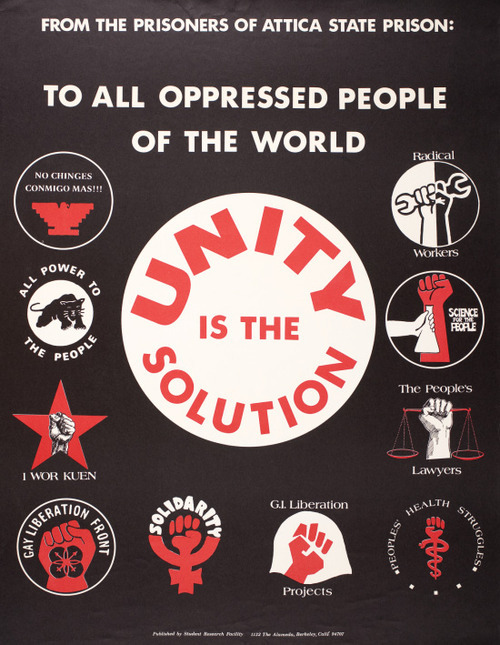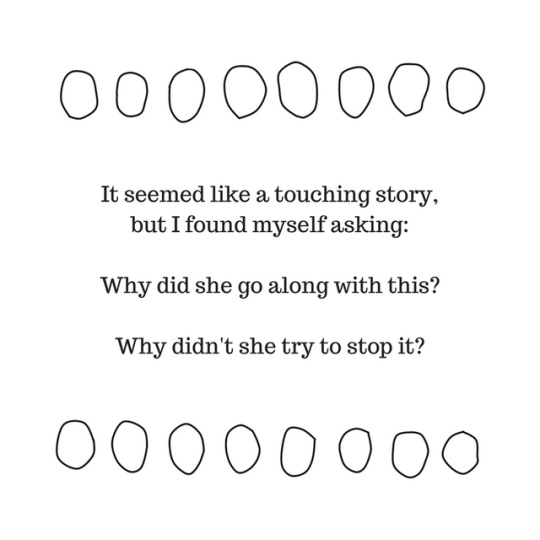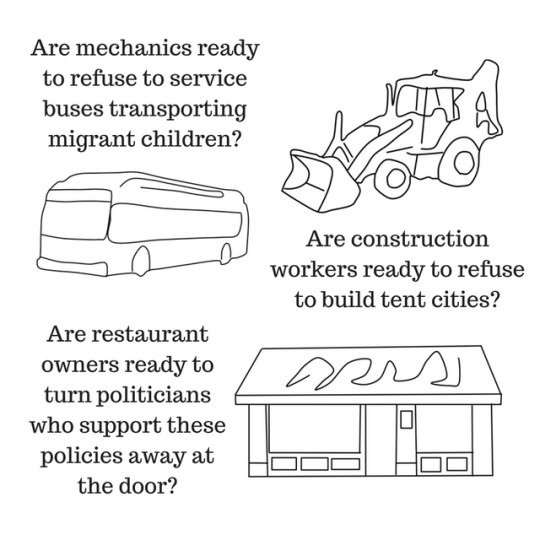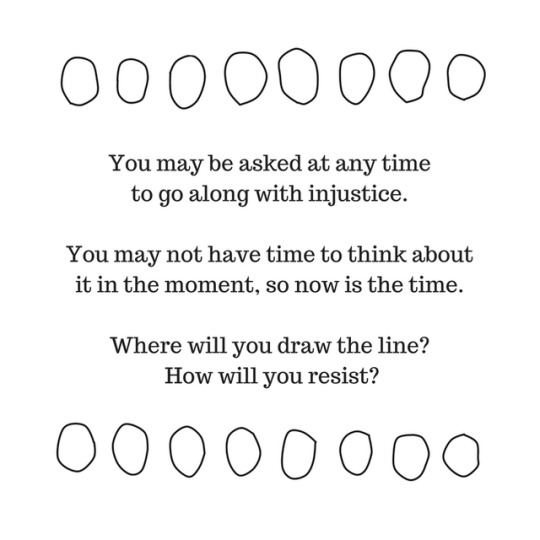Photo

September 9 -14, 1971: The Attica prison uprising
2K notes
·
View notes
Text
Never ever turn off your phone: rethinking security culture in the era of big data analysis.
Back in the 80′s if you were a pissed off anarchist that wanted to burn down a building, you probably checked your home for listening devices and made a plan. If you were the same kind of pissed off anarchist in the late 90′s, you turned off your phone and encrypted your online traffic. In the 2020′s we’re gonna have to change our strategies once again. Intelligence gathering has adapted and so we must adapt too.
To get a head start at this, let’s look at how big data analysis is being used. To do this, we’ll need to talk about 3 things: metadata, patterns and networks. Those sound boring and complicated but I’m not a techy and I won’t bore you with tech language, I’ll keep it as easy as I can.
Metadata: In the context of online activity, ‘content’ means ‘the message you send’ and ‘metadata’ means ‘everything other than the content’. So, for example, if you send your friend a text about lunch, the content might be “Let’s go out for lunch” and the metadata might be “Message send at 01/04/2018 11.32 from phone 0478239055 to phone 079726823 using Signal”.
This information is registered by your phone even if the app encrypts your actual message. Your metadata is very badly protected by technology and very badly protected by the law. No matter which country you are in, most of your metadata if freely available to intelligence agencies regardless of whether you are a suspect in anything.
Patterns: Whether you realize it or not, your metadata has a pattern. If you have a daily job you might have a very consistent pattern, if you do not your pattern might be more flexible but you have a pattern. If someone wanted to know the rhythm of your day, they could very easily do so because your pattern is in the metadata.
For example: Maybe you use the wifi at your favourite bar on most Sunday nights until about midnight, you wake up around 10 AM and check your Signal, you use your public transport card to get to class every Monday afternoon and you spend on average 1 hour on Tumblr twice a day. All this is part of your pattern.
Networks: You have online networks. Your facebook friends, the people in your phone adress book, the dropbox you share with coworkers, everyone who bought online tickets to the same punk band you attended, the people using the same wifi points as you. Take your networks, combine them with other people’s networks, and clusters reveal themselves. Your work community, your family, your activist scene, etc.
If you are in an anarchist community that will probably be abundantly clear from all your minor network connections like going to the same band and knowing the same people as other anarchists. Even if you never liked an anarchist facebook page or pressed ‘going’ on an anarchist facebook event, your network is hard to hide.
Now, let’s say you commit a crime,
the kind that would result in some serious research. Let’s say that on Sunday night 3 AM, you are your friends go out and burn down a nazi’s house. (Of course I would never advice any of you to do such a thing.) It’s obvious that anarchists did it but there are no other clues. You use traditional style security culture: you burn your notes, you are careful not to communicate about your plans near technology and you do not leave physical traces.
But because you commited the crime that night, your metadata will vary strongly from your usual rhythm: you stay at your usual bar until 2 AM to wait for your friends, you do not wake up at 10 AM in the morning so you do not check your Signal or Tumblr until 1 PM. You do not go to class. Your metadata pattern is very different from your usual pattern. The metadata patterns of your friends are different too. If one of you is clumsy, they might generate a super suspicious metadata signal like a phone being switched off at 2.30 AM and activated at 4AM. You wouldn’t be the first.
If I wanted to solve this crime using data analysis, what I would do is:
let a piece of software run a pattern analysis of the local anarchist scene to generate the 300 people most connected to the anarchist scene.
let a second piece of software analyse the metadata patterns of those 300 people over the last months and identify the biggest metadata variations around Sunday night as well as very suspicious metadata activity
Illiminate pattern variations with an obvious cause or an obvious alibi (people who are on vacation, people who are in the hospital, people who lost their job, etc).
Do indepth research into the ones that remain.
Which is how, out of a massive amount of people that I couldn’t possible all listen to at the same time, I could quickly identify a few to monitor closely. This is how I could find and catch you.
So, now what?
If traditional security culture doesn’t protect us as well as it used to, how do we adapt? Well, I don’t have all the answers but for a start, I’d say: know your network + know your pattern.
In the case of the example above: leave the bar at midnight, return home and put your phone on your bedside table. Check the apps you check before going to bed and set your alarm to 10AM. Return to the bar without your phone. Wake up at 10AM and check your Signal. Drag yourself to class or ask a comrade to make the trip with your travel card and do not use technology in your home while the comrade is taking your travel card to class. Stick to your pattern. Never ever turn off your phone.
You might also be able to manipulate your network but that seems much harder to do. Not having a smartphone and dropping out of all social activity online is a big commitment. Knowing your data pattern and making sure your data pattern doesn’t look out of the ordinary? Much less commitment.
Some of the old rules will still apply: don’t talk about a crime around devices with microphones, don’t brag after a succesful action, etc. Other rules, like ‘turn off your phone when planning an illegal act’ need to change because their metada looks too out of the ordinary. No one switches off their phone anymore. We look suspicious as fuck when we do.
This is just one idea on how we could update our security culture. There are probably other people with other, better ideas about updating our security culture. If we start the conversation, we may get somewhere.
Finally: we need to keep adapting.
As technology changes, more information is becoming available, including data we have very little control over. Smart-tv’s and ads in public spaces that listen to every word we say and the tone of our voice when we say it are examples. Data analysis projects are currently using license plate reading software on security footage to map the travel patterns of cars. A lot suggests they may soon be ready to do the same with face recognition, at which point the presence of our face in public space becomes part of our metadata. More information means more accurate data analysis. Our metadata may soon be too vast annd too complex to completely map and mirror. Which means we will need to adapt our counter measures if you want to hide something.
How do we keep it all under the radar? I don’t know. But let’s try to figure this shit out. These are some first thoughts about what security culture should look like in the age of modern big data analysis and I’d be very happy for any insights from comrades that have some thoughts on this.
Also: feel free to distribute and rework these words without credit.
29K notes
·
View notes
Text
All Out for August! Fight Fascism, but Keep the Pressure on the State
August is shaping up to be a busy month in the United States, with a convergence of struggles against fascist organizing, the prison-industrial complex, and the violence of the border as exemplified by Immigration and Customs Enforcement (ICE). With our comrades at Submedia and It’s Going Down, we’ve prepared a short video addressing the situation. Below, we follow it with a few remarks about the situation.
vimeo
All out this August!
Shut Down Fascism
We’re seeing a new wave of activity from the fascist movement that was so soundly beaten in the streets a year ago. On July 28, the Nazis of Patriot Front carried out a cowardly surprise attack on Occupy ICE in San Antonio. This August, the same fascist groups that terrorized and murdered people last year are preparing to rally around the US again—everywhere from Providence and Washington, DC to Portland and Berkeley.
Fascists are the street wing of the Trump agenda. We have to shut them down wherever they organize. But above all, we can’t let them stop us from standing up to the state, the chief source of authoritarian violence.
“These goons are of great use to the authorities. They can carry out attacks that the state is not yet able to, intimidating those who might otherwise rebel. They distract from the institutionalized violence of the state, which is still the cause of most of the oppression that takes place in our society. Above all, they enable the authorities to portray themselves as neutral keepers of the peace.”
-“Why the Alt-Right Are So Weak”
vimeo
All out for Portland!
And Keep the Pressure on ICE
For years, people concerned about the violence of the border sought a point of intervention to take action against it. At the beginning of the Trump era, we proposed that people build on the example of the airport blockades by shutting down ICE offices. This summer, the Occupy ICE model finally took off, with occupations all around the United States.
The movement has managed to accomplish a lot with a relatively small amount of people. Unlike astroturf movements like the March for Our Lives that rapidly became promotional events for the Democratic Party, Occupy ICE has offered agency to the exploited and excluded and achieved a direct impact. This has included direct aid and solidarity for the struggles of immigrants, halting specific deportations, and delaying deportations on a larger scale. Occupy ICE has blocked the Trump administration’s policy of breaking up families and forced Trump to try to distance himself from his own policy.
In short, direct action gets the goods: we don’t need political parties to make change, we can take action ourselves to force the state to stop what it is doing.
Unlike the top-down decision involving the FBI and DHS to clear the Occupy encampments in coordinated attacks, the Trump administration has thus far permitted cities to handle the encampments on their own, presumably for fear that centralized repression would backfire. In response, fascists and others on the far right have taken on the task attacking the encampments themselves, following in the footsteps of DHS agents. The fascists aspire to act as an auxiliary force of repression to do what the forces of the state cannot currently do.
However, this strategy can backfire for reactionaries who hold state power. The failure of the “Unite the Right” demonstration in Charlottesville a year ago cost the Trump regime dearly. Likewise, the decision to rely on evidence provided by far-right surveillance vigilantes Project Veritas cost prosecutor Jennifer Kerkhoff the entire J20 case. When fascists and other grassroots reactionaries overextend themselves, their failures can undermine the legitimacy of the reigning party they hope to support. We have to see fascist attacks as an opportunity to seize the initiative in our struggle against the state.
Above all, fascists would like us to narrow the scope of our efforts to countering their organizing; they aim to trap us in a private grudge match while the state continues to mass-incarcerate and deport people. We beat them by organizing movements that can take on the chief source of oppression, the state itself.
The organizers of a looming nationwide prison strike have expressed solidarity with Occupy ICE, linking the fight against prison slavery to the call to abolish ICE. This has come in the form of statements from prison strike leaders in support of Occupy ICE and also recent hunger strikes in solidarity with hunger-striking migrant detainees. When prisoners unite across racial lines against prison slavery, it’s up to us to do the same on the outside.
So in solidarity with #AllOutAugust, we encourage people to continue to organize blockades against ICE facilities; to continue to defend Occupy ICE camps and reenergize them with events, music, films, and discussions; and to mobilize solidarity around the prison strike, as well. It is easy to draw links between resistance to prison slavery and the fight to abolish ICE and the borders it violently enforces. Continuing to support the Occupy ICE camps and anti-ICE blockades is one of many ways to act in solidarity with the prison strike.
Entering into open conflict with fascists is often terrifying. Yet we hope that the movement for a world without oppression can come out of the trying events of August stronger—and that as the summer comes to a close, the struggles against borders, fascists, and police violence will converge in new ways and gain new momentum.
Good luck out there, dear comrades.



191 notes
·
View notes
Photo







This isn’t what I usually write about, but I think it’s important.
118K notes
·
View notes

























